Our Tips for Mastering Project Resource Planning
1 Jun 2021
Ask most project managers what their number one challenge is when delivering great projects, and we’d bet most of them would say resource planning. Without getting the right people working on the right things at the right time, you’re unlikely to deliver your project on time.
But don’t worry, there’s a whole range of techniques out there to help you get a grip on your resourcing. With a bunch of software tools on the market that also offer an extra helping hand!
In this article, we’re going to deep dive into resource planning to help you get a handle on managing your project team’s time. After we’ve looked at precisely what resource planning is, we’ll walk through how it’s done before. And then we’ll finishing up by showing you how OpenCRM can help get some control around your resourcing.
Let’s get started!
Quick Links:
- What is Resource Planning?
- Why is Resource Planning so Important?
- 5-Step Guide to Resource Planning
- Project Resource Planning in OpenCRM
What is Resource Planning?
At its highest level within project management, Resource Planning is the process of systematically assigning qualified people to complete tasks within a project.
From that definition, it sounds pretty simple, right? Wrong! Resource planning is an ever-moving landscape that requires weekly, daily and sometimes even hourly re-prioritisation.
It’s also a massive balancing act. Those in charge of resource planning must be careful not to under or over utilise resources to ensure they get the optimum value out of what they have.
Often this is achieved through a resource plan which will give a clear visual representation of the tasks to be completed and the resources assigned to them.
Whether you’re in charge of a single project or a more extensive portfolio, the key to nailing your resourcing is to estimate your future work as accurately as possible to allow you to best forecast the resource needs.
[ocrm-casestudies]
Why is Resource Planning so Important?
There’s a whole host of reasons why getting resourcing right is so important. Here are just three of the ways poor resource planning can cause you and your project a headache:
- You deliver late. A pretty simple one, but also the most dangerous. Failure to get resources working on your project at the right time will mean tasks don’t get completed. Tasks not getting completed means you fail to meet your timelines, and you’ll deliver your project late.
- You don’t optimise your budget. If you haven’t got a good grip on your resource planning, your budget can end up going out the window too. Failure to get the right resources on your project may mean you underspend, whilst not managing your resources correctly may lead you to incur additional costs. If you want to keep the finance teams happy, it pays to plan your resource upfront.
- Your outputs suck. When Project Managers are up against it, they often scramble to get their hands on any resource they can. This should be avoided! It’s all about getting the right resource on board to ensure the quality of the project doesn’t suffer. Sometimes it can be better to re-organise tasks to suit the schedule of the right resource rather than settling for the first person available.
5-Step Resource Planning Process
Now we know what resource planning is and why it’s so important to get right within your projects. So here’s a quick 5 step guide to help you plan out your project workload.
Step 1 – Break Down The Deliverable
The first thing to understand is the tasks required to deliver your project. This isn’t always an easy job, given the way projects can move and change over time.
Especially in larger organisations, the chances are someone has completed a similar type of project before. Draw on the knowledge and expertise of others to understand the work required to get you from A to B.
If that insight isn’t available, it sometimes serves best to break your deliverable down using a product breakdown structure. Here you separate out the component parts of your project deliverable to better understand how it all comes together.
Case Study – Imagine your managing a website project. Break down the component parts of that website and what needs to be done to deliver them. In this example that may include designing the pages, developing the code, writing the content, testing the buttons etc.
Step 2 – Estimate The Work
Now you know all of the components that make up your project, it’s time to start estimating how long each of them will take.
If you have no prior knowledge of the tasks you’re delivering, you’ll just have to estimate as best you can. Again there’s some help available here – why not try utilising the 3 point estimate technique, for example?
Take a weighted estimate of the shortest, longest and average time you think a task will take to complete. Then, you’ll have an excellent foundation to understand your resource requirements.
For each task, you ultimately need the following information:
- When it will start
- When it will end
- How long it will take (the difference between start/end)
- Dependencies (do certain tasks have to finish before others can start?)
- Estimate confidence (high/medium/low)
Estimate confidence is a great way to forecast any contingency you may need. Apply a variable buffer to your time estimates to mitigate any uncertainty. For medium confidence, add an extra 20%, for low confidence, another 40%.
Case Study – With each of the tasks in your website build broken down, you can start to estimate how long each one will take to complete. For example, based on some online research, you find information to suggest an individual web page can be designed in 1-3 hours.
[ocrm-freetrial]
Step 3 – Confirm the Skill Level Needed
We’ve mentioned it a few times, but the key to executing great resource planning is to make sure you get the right resource. Not just the next available resource.
Try to gauge the level of knowledge and experience required to complete the task(s) needed to deliver your project. Getting this right will positively affect both your project timescales and project quality.
You need to ensure you get a competent resource who can deliver what you need at the right pace to keep up with your timelines. If you can afford it, often the more senior resources have the knowledge and expertise to deliver work faster. And will be less likely to slow the project down!
Case Study – To be sure, you decide your project needs a web designer with at least four years of experience. This level of seniority gives you confidence they can meet the 1-3 hours per page estimate and fits within your budget.
Step 4 – Find & Assign The Right Resource
Now it’s time to find the resource to help you deliver the tasks you need. Are there a bank of individuals in your organisation? Look into your resource planning tool to identify those that are free.
If you need to hire externally or utilise a freelancer, make sure you clearly state when you need them to be available and how long for. This will ensure your project has precisely what it needs.
And, if you can, build in some contingency to the resource allowance. Things can always go wrong when planning projects. So it pays to give a little bit of buffer time in your timelines to factor in for any uncertain events. (This also feeds in from your task confidence assessment in Step 2).
Case Study – You look at the resource plan and see that only a junior web designer is available when you need them. Knowing that you need someone more senior, you agree with your organisation to hire an external freelancer to work on the task.
Step 5 – Monitor and Learn
Resource planning is often more of an art than a science. As your project(s) progress, you’ll need to monitor your resource allocation and compare it against your initial resource plans.
Did specific tasks take longer than expected? Was there the right level of expertise from your resource? Did you manage to plan far enough ahead to secure the right resource?
As your project progresses, you’ll be able to answer these type of questions. Remember to record your experiences and even share them with other Project Managers in your organisation to help you all with your resource planning moving forward.
Case Study – As the project progresses, the web designer manages to complete each of your website pages in around 3 hours. This means the original 1-3 hour estimate was accurate but at the higher end of the range. You take this learning forward to your next project knowing that 3 hours is the benchmark for a task of this type for a senior individual.
Resource Planning in OpenCRM
Now that we’ve seen a high-level view of how to estimate work and assign resource, we should probably show you how we do it in OpenCRM. The Projects module is the start point for all things project management, with Calendars and Activities all playing their part too.
Let’s take a look!
Step 1 – Set up a Project
When your project kicks off, jump into OpenCRM and log a Project record. Here you can input all the details you need, including the start and end dates, project resource hours and the available budget.
You can also link the Project to the relevant Contact and Company record. This will help you with sending automated project updates to your clients.
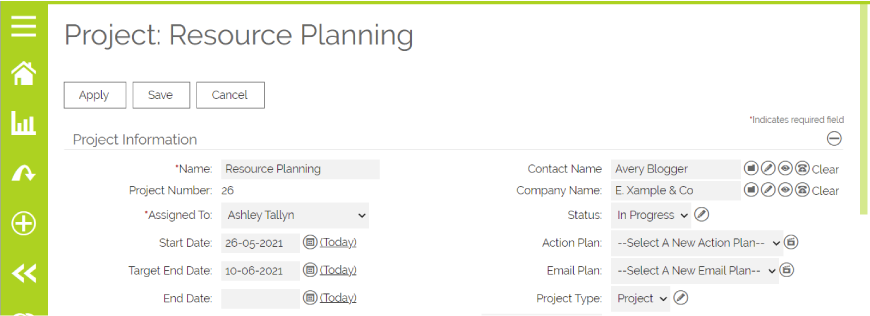
[ocrm-webinar]
Step 2 – Create your Project Tasks
Now it’s time to get into breaking your project down into individual tasks. There are several ways to do this using OpenCRM Activities.
If your projects always follow a set skeleton process, you could use an Action Plan to create and schedule those key milestones and tasks. Alternatively, if each of your projects is slightly different, you’ll likely want to create each of these Activities individually.
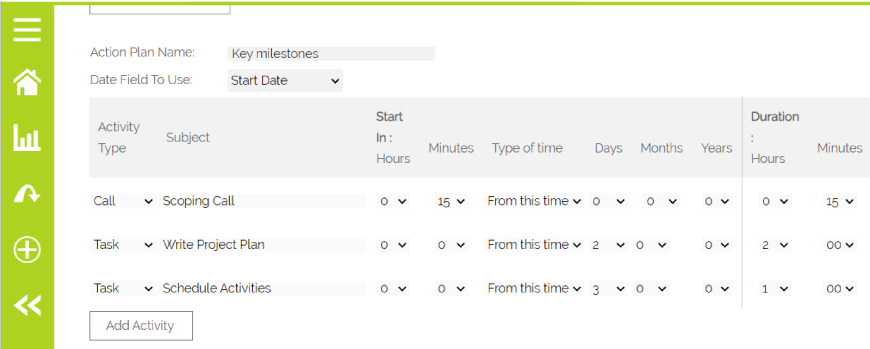
Once all your tasks are created, make sure you click on the Project Calendar button. It will give you an overall view of the entire Project and the Tasks required to deliver it.
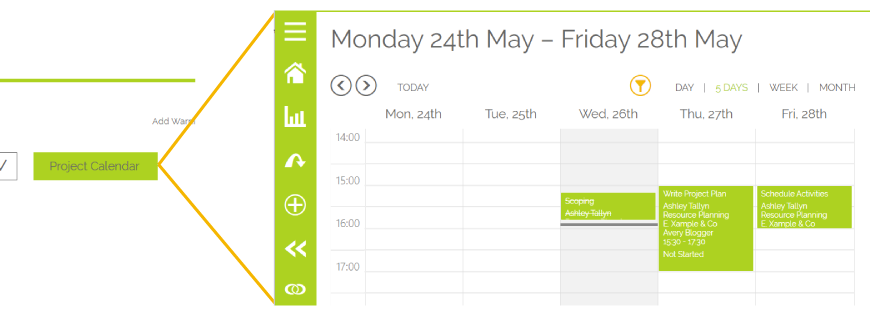
Step 3 – Assign the Project Tasks
With your project tasks created, it’s now time to assign them to members of the team.
Jump over to the Calendar and filter it to show those users who you think will work well on this Project. By seeing everything in a combined calendar view you can easily see who has free time and who is busy.
And because you’ve already created all the Activities against the Project, you can see who has what tasks on already. In the example below, we can see that Frank is already tied up in a workshop. So someone else will have to design page one of our website.
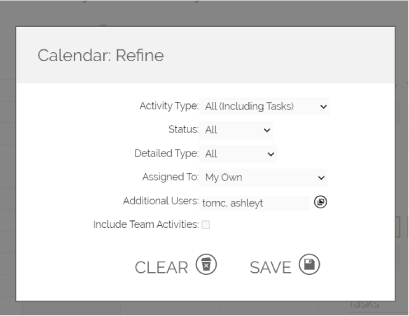
You can do this for all of your tasks until each of your project activities has been assigned to a team member.
Step 4 – Monitor the Progress
As the project progresses, you’ll be able to keep a record of what’s been done and what’s still left to do.
For a high-level overview, looking at the Project Time block will show you how much time you’ve budgeted, how much time has been completed, and how much time is still remaining. You’ll also see if you’ve started to overrun.
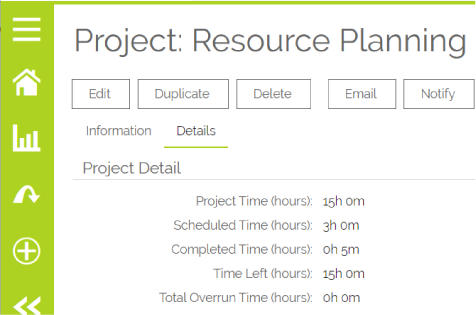
When you want the detail, of course, you’ll be able to see the tasks completed in the History. As well as those outstanding in the Pending tab.
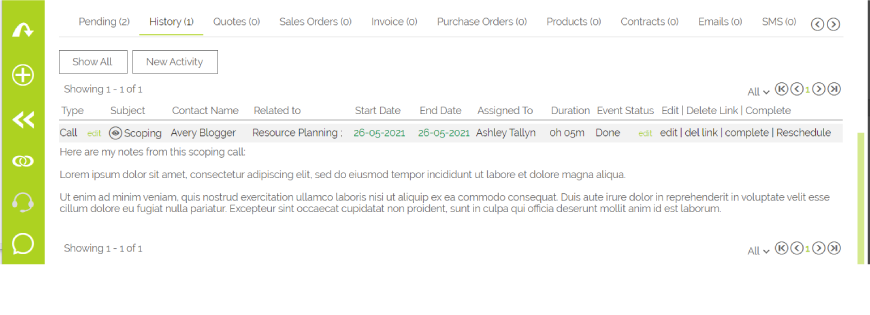
As project tasks get completed, you’ll automatically see the resource allowance of your project adjust. This allows you to keep track of the number of resource hours left so you can monitor project progress and re-plan if needed.
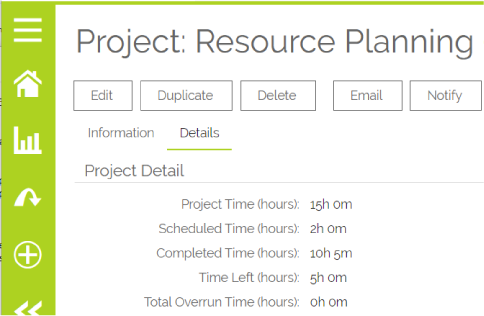
You can also see this information through Project Reports. You can even create a graphical view of project progress that’s perfect for sharing with external clients.
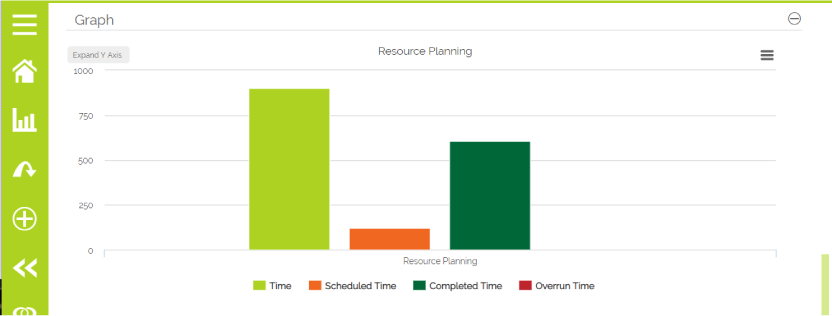
[ocrm-customdemo]
Summary
Resource planning is one of the trickiest areas to get right in project management. The key to success is to get ahead of estimating and planning the tasks within your project, to identify who is best to pick them up.
Task estimation and the associated resource planning is something you’ll get better at as a Project Manager over time. Remember to look back at your previous resource planning efforts to improve your task estimation for the next project.
Tools such as OpenCRM help to make the process of resource planning easier by keeping all of your team’s workloads in one place. This makes it easy to see what everyone has on and which resource will be free to help you complete the tasks you need to deliver a great project!

James Elliott is a Project Manager, Writer and Ex-OpenCRM’er from London. When not working to deliver projects, James writes on a variety of business topics as well as delivering online project management training. You can check out James’ work on his website or by connecting on LinkedIn.